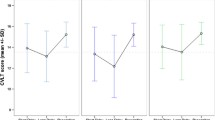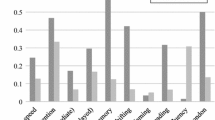Abstract
Introduction
Cognitive deficits, including deficits in early information processing, are associated with remitted bipolar disorder. The temporal relationship between these deficits and the clinical course is not known. The current study investigated whether or not deficits in early information processing were present before the onset and/or during the early stages of bipolar disorder.
Methods
Unaffected and remitted high risk offspring of well-characterized bipolar parents completed a visual backward masking task. For comparison we included a cohort of unaffected offspring of well parents and a clinically referred group of remitted bipolar patients.
Results
There was no evidence of a deficit in early information processing in well high risk subjects. As expected, the referred patient group had the highest error rates. After excluding the patients, interaction effect showed that the affected remitted high risk subjects performed differently in terms of error rates than unaffected high risk and control subjects. There were no significant differences in response times across study groups. Exploratory analyses revealed an association between a lifetime history of psychosis and increased errors on the task.
Conclusions
There was no evidence of a vulnerability in early information processing in offspring at risk for bipolar disorder. However, there were emergent changes in performance in the affected remitted high risk group. Psychosis appears to be an important clinical correlate associated with cognitive deficits. Mapping of the early course of bipolar disorder and associated changes in cognition has important implications for establishing critical periods for intervention.


Similar content being viewed by others
References
Alda M, Grof P, Rouleau GA, Turecki G, Young LT (2005) Investigating responders to lithium prophylaxis as a strategy for mapping susceptibility genes for bipolar disorder. Prog Neuropsychopharmacol Biol Psychiatry 29:1038–1045
Alda M (2004) The phenotypic spectra of bipolar disorder. Eur Neuropsychopharmacol 14(Suppl 2):94–99
Blacker D, Tsuang MT (1993) Unipolar relatives in bipolar pedigrees: are they bipolar? Psychiatr Genet 3:5–16
Duffy A, Alda M, Crawford L, Milin R, Grof P (2007) The early manifestations of bipolar disorder: a longitudinal prospective study of the offspring of bipolar parents. Bipolar Disord 9: 828–838
Duffy A, Alda M, Kutcher S, Cavazzoni P, Robertson C, Grof E, Grof P (2002) A prospective study of the offspring of bipolar parents responsive and non-responsive to lithium treatment. J Clin Psychiatry 63:1171–1178
Duffy A, Alda M, Kutcher S, Fusee C, Grof P (1998) Psychiatric symptoms and syndromes among adolescent children of parents with lithium-responsive or lithium-nonresponsive bipolar disorder. Am J Psychiatry 155:431–433
Endicott J, Spitzer RL (1978) A diagnostic interview: the schedule for affective disorders and schizophrenia (SADS). Arch Gen Psychiatry 35:837–884
Green MF, Kern RS, Braff DL, Mintz J (2000) Neurocognitive deficits and functional outcome in schizophrenia: are we measuring the “Right Stuff”? Schizophr Bull 26:119–136
Green MF, Nuechterlein KH, Breitmeyer B, Mintz J (2006) Forward and backward visual masking in unaffected siblings of schizophrenic patients. Biol Psychiatry 59:446–451
Green MF, Nuechterlein KH, Mintz J (1994) Backward masking in schizophrenia and mania. I: specifying a mechanism. Arch Gen Psychiatry 51:939–944
Green MF, Nuechterlein KH, Mintz J (1994) Backward masking in schizophrenia and mania. II: specifying the visual channels. Arch Gen Psychiatry 51:945–951
Grof P, Alda M, Grof E, Zvolsky P, Walsh M (1994) Lithium response and genetics of affective disorders. J Affect Disord 32:85–95
Hajek T, Bernier D, Slaney C, Propper L, Schmidt M, Carrey N, MacQueen G, Duffy A, Alda M (2008) Comparison of affected and unaffected relatives of bipolar patients with magnetic resonance spectroscopy. J Psychiatry Neurosci (in press)
Hajek T, Gunde E, Bernier D, Slaney C, Propper L, Grof P, MacQueen G, Duffy A, Alda M (2008) Subgenual cingulate volumes in affected and unaffected offspring of bipolar parents. J Affect Disord (in press)
Hajek T, Carrey N, Alda M (2005) Neuroanatomical abnormalities as risk factors for bipolar disorder. Bipolar Disord 7:393–403
Kaufman J, Birmaher B, Brent D, Rao U, Flynn C, Moreci P, Williamson D, Ryan N (1997) Schedule for affective disorders and schizophrenia for school-aged children—present and lifetime version (K-SADS-PL): initial reliability and validity data. J Am Acad Child Adolesc Psychiatry 36:980–988
Keri S, Benedek G (2007) Visual contrast sensitivity alterations in inferred magnocellular pathways and anomalous perceptual experiences in people at high-risk for psychosis. Vis Neurosci 24:183–189
Keri S, Kelemen O, Benedek G, Janka Z (2001) Different trait markers for schizophrenia and bipolar disorder: a neurocognitive approach. Psychol Med 31:915–922
Keri S, Must A, Kelemen O, Benedek G, Janka Z (2006) Development of visual motion perception in children of patients with schizophrenia and bipolar disorder: a follow-up study. Schizophr Res 82:9–14
Kessing LV (1998) Cognitive impairment in the euthymic phase of affective disorder. Psychol Med 28:1027–1038
Kyte Z, Carlson GA, Goodyer IM (2006) Clinical and neuropsychological characteristics of child and adolescent bipolar disorder. Psychol Med 10:1–15
MacQueen GM, Grof P, Alda M, Marriott M, Young LT, Duffy A (2004) A pilot study of visual backward masking performance among affected versus unaffected offspring of parents with bipolar disorder. Bipolar Disord 6:374–378
MacQueen GM, Young LT, Galway T, Joffe RT (2001) Backward masking task performance in stable, euthymic out-patients with bipolar disease. Psychol Med 31:1269–1277
MacQueen G, Young LT, Galway T, Joffe R (1998) Impaired performance on a backward masking task in euthymic bipolar patients. Presented at the Society for Biological Psychiatry annual meeting, Toronto, Ontario, June
MacQueen GM, Young LT, Joffe RT (2001) A review of psychosocial outcome in patients with bipolar disorder. Acta Psychiatr Scand 103:163–170
Martinez-Aran A, Vieta E, Colom F, Reinares M, Benabarre A, Gasto C, Salamero M (2000) Cognitive dysfunctions in bipolar disorder: evidence of neuropsychological disturbances. Psychother Psychosom 69:2–18
Martinez-Aran A, Vieta E, Torrent C, Sanchez-Moreno J, Reinares M, Benabarre A, Goikolea JM, Brugue E, Daban C, Salamero M (2004) Cognitive impairment in euthymic bipolar patients: implications for clinical and functional outcome. Bipolar Disord 6:224–232
Meyer SE, Carlson GA, Wiggs EA, Martinez PE, Ronsaville DS, Klimes-Dougan B, Gold PW, Radke-Yarrow M (2004) A prospective study of the association among impaired executive functioning, childhood attentional problems, and the development of bipolar disorder. Dev Psychopathol 16:461–476
Murray RM, Sham P, Van Os J, Zanelli J, Cannon M, McDonald C (2004) A developmental model for similarities and dissimilarities between schizophrenia and bipolar disorder. Schizophr Res 71:405–416
Robinson LJ, Ferrier IN (2006) Evolution of cognitive impairment in bipolar disorder: a systematic review of cross-sectional evidence. Bipolar Disord 8:103–116
Suslow T, Arolt V (1998) Backward masking in schizophrenia: time course of visual processing deficits during task performance. Schizophr Res 33:79–86
Turecki G, Grof P, Cavazzoni P, Duffy A, Grof E, Ahrens B, Berghofer A, Muller-Oerlinghausen B, Dvorakova M, Libigerova E, Vojtechovsky M, Zvolsky P, Joober R, Nilsson A, Prochazka H, Licht RW, Rasmussen NA, Schou M, Vestergaard P, Holzinger A, Schumann C, Thau K, Rouleau G, Alda M (1998) Evidence for a role of phospholipase c-y1 in the pathogenesis of bipolar disorder. Mol Psychiatry 3:534–538
Acknowledgment
The authors would like to thank Ms Leah Crawford for her assistance with this manuscript.
Financial Disclosures
Dr. Duffy was the recipient of an Intermediate Investigator Award from the National Alliance for Schizophrenia and Affective Disorders (NARSAD) and a Canada Research Chair Tier II in Child Mood Disorders (CRC). This study was sponsored by operating grants from the Ontario Mental Health Foundation (OMHF) and from the Canadian Institutes of Health Research (CIHR). The authors have no financial or potential conflict of interest to disclose with respect to the subject matter of this paper.
Author information
Authors and Affiliations
Corresponding author
Rights and permissions
About this article
Cite this article
Duffy, A., Hajek, T., Alda, M. et al. Neurocognitive functioning in the early stages of bipolar disorder: visual backward masking performance in high risk subjects. Eur Arch Psychiatry Clin Neurosci 259, 263–269 (2009). https://doi.org/10.1007/s00406-008-0862-3
Received:
Accepted:
Published:
Issue Date:
DOI: https://doi.org/10.1007/s00406-008-0862-3




